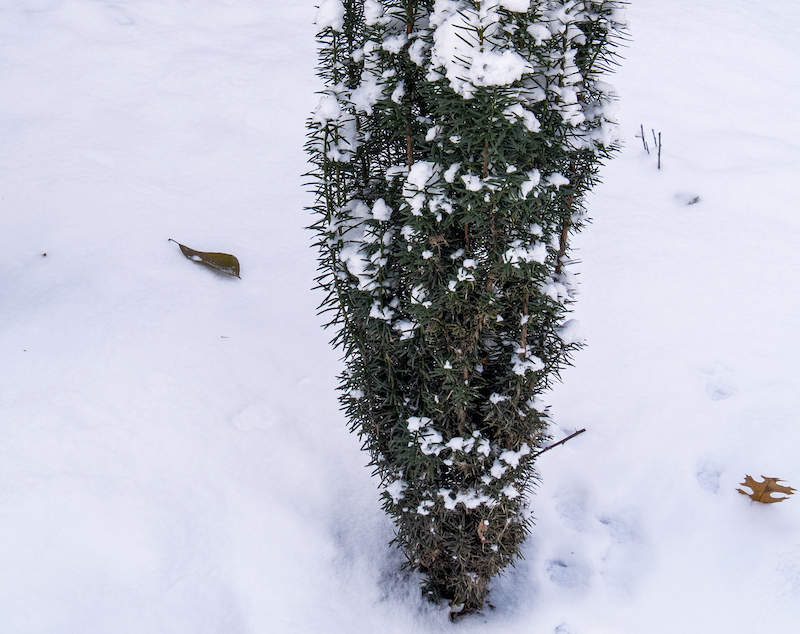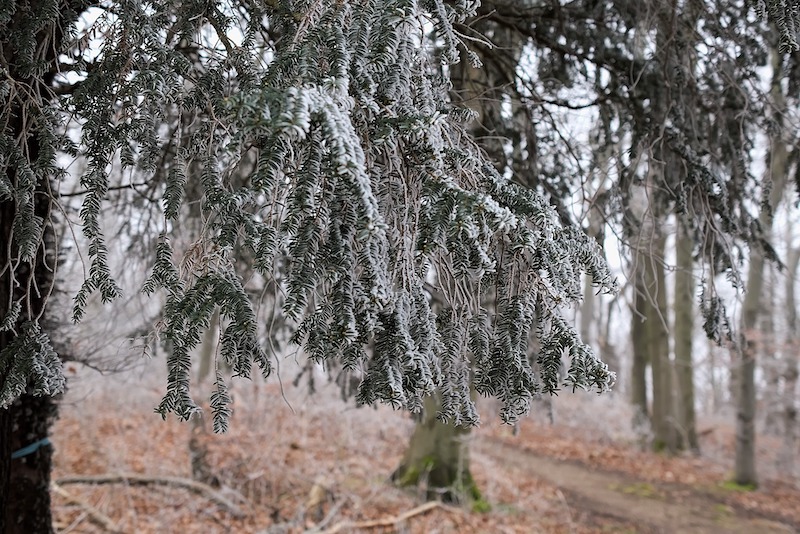One of the best reasons to plant a yew is to add a splash of green color to otherwise dreary winter landscapes. So, it may be particularly important to ensure that any yews are well prepared to thrive and maintain a healthy green appearance even in the depths of winter. Yew grow in USDA zones 3 or 4 to 8, so they are easily able to withstand winter weather in many areas. While these plants are hardy enough to tolerate cold temperatures, the narrow needles leave them particularly prone to drying out, or winter desiccation. Yews are also particular favorites of deer in the winter, so if these animals are prevalent in a region, the yews may require additional winter protection.

Protecting Yews in Winter
A layer of organic mulch spread in a layer 2 to 3 inches thick over the root mass will help to conserve moisture around the roots.The goal with winter protection is to minimize water loss through the needles while the plant is unable to take up sufficient moisture through its roots. Physical protection from wind will stop some of this water loss through needles. An anti-dessicant, sometimes also called an antitranspirant, can be sprayed onto needles, typically 2 or 3 times each winter. One additional winter consideration for yews is protection from deer. Fencing yews off or wrapping plants with burlap can be effective if installed correctly. Repellent sprays and other products are also available but require multiple applications to deter deer all winter long.
Cutting Back Yews For Winter
Pruning to shape the yew should not occur in preparation for winter. Instead, wait until late winter to shape the yew and maintain its health. Avoid cutting the yew back significantly in mid-summer to fall, as this can force new growth that is vulnerable to winter damage. Remove damaged or diseased branches as you notice them and clear any diseased needles that have gathered around the base of the plant.

Yews Winter Care in Pots
Yews are occasionally valued as container specimens or topiaries kept in containers. If it is possible, move these container plants into more protected areas out of harsh winds. In areas with especially low temperatures, such as USDA zones 4 and 5, consider partially burying containers or creating a blanket of mulch around the container and above the soil. This will imitate the protection that soil and snow offer yews grown in-ground. High-value container specimens can also be wrapped in burlap for extra protection.
Watering Yews in Winter
Regular moisture during the growing season will prepare yews to survive harsh winter weather. In areas where the ground freezes, simply plan to give the yew a thorough, slow soaking just before putting away hoses and watering cans for the winter. If the ground does not freeze in your location, occasional watering may be necessary if there is little or no rainfall.
Growing Yews Indoors
Yews typically prefer a period of dormancy during winter. Most yews are cold hardy and well suited to outdoor temperatures. It is unnecessary to bring yews indoors and may allow pests and diseases to flourish. If maximum winter protection is desired, move container specimens out of the wind or keep them in an unheated outbuilding.
Steps To Care For Yews in Winter
Proper care throughout the growing season will encourage a yew to survive winter and emerge healthy in spring. Adequate soil moisture and minimizing water loss through the plant’s needles will keep browning down. Hungry deer also tend to seek out yews when other food is scarce, so it may be necessary to take steps to repel these four-legged pests.
Step 1 - Water yews deeply just before winter if rainfall has been lacking. With the last watering of the year, try to soak the ground to a depth of about 18 inches.
Step 2 - Set up any snow fencing or wrap the yew with burlap just before the ground freezes. This will help to minimize winter desiccation.
Step 3 - Apply deer repellent according to label directions if you anticipate deer will soon be in the area.
Step 4 - Inspect the yew following heavy snowfalls. Heavy snow may weigh down and split branches. Simply brush off heavy snow piles.
Step 5 - Prune the yew as any damage appears. Simply cut broken branches off to a convenient location further back on the branch.
Step 6 - In late winter, perform annual dormant winter pruning. Cut off any branches that show significant needle discoloration or dieback and remove broken or out of place branches while also shaping the plant.
 |
Author Angela Ryczkowski - Published 4-10-2023 |
